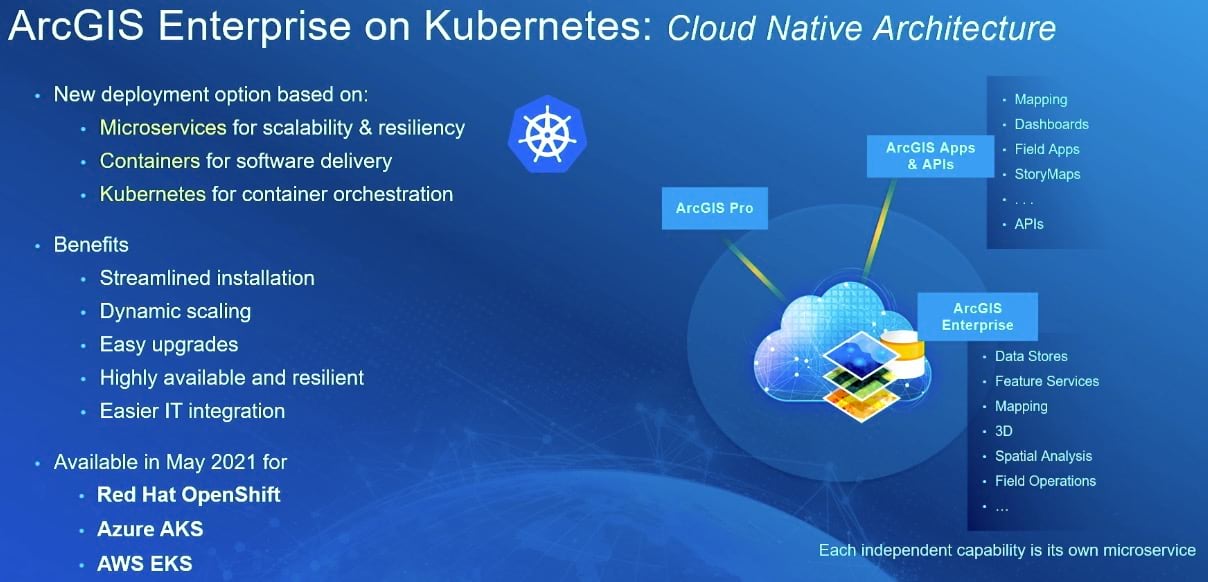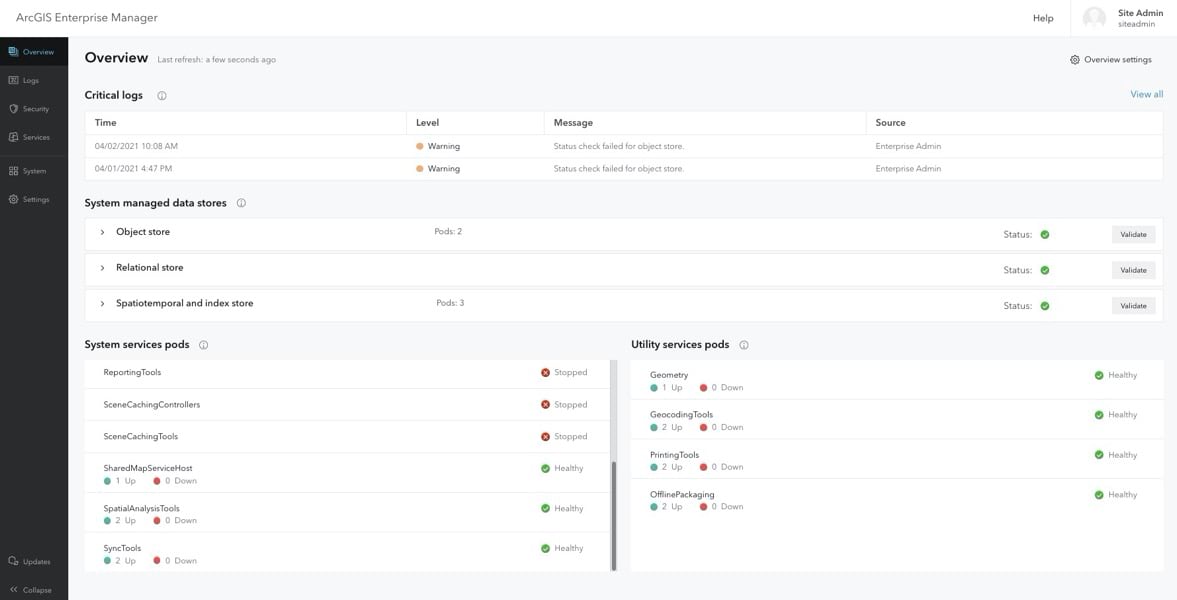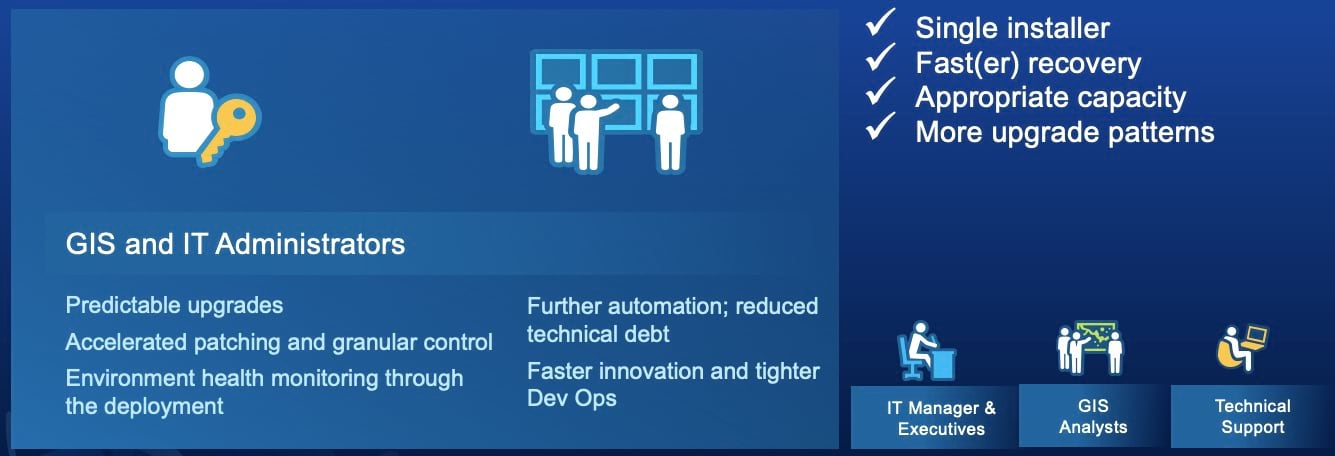ArcGIS Enterprise on Kubernetes launched in 2021. In this article, learn more about the cloud native architecture available to our customers that use ArcGIS.
Esri has been sharing our vision of the emerging Geospatial Infrastructure, which describes how we see the world becoming more interconnected and collaborating more closely than ever on the many challenges and opportunities that affect us all. “Helping you see what others can’t” is one of the key advantages of ArcGIS, a comprehensive Geographic Information System that helps you with location mapping, analytics, and collaboration. ArcGIS is implemented through multiple patterns such as Software as a Service, Platform as a Service, and desktop and server software. ArcGIS Enterprise helps you implement GIS in your own infrastructure, running on-premises or on the cloud. The latest release of ArcGIS Enterprise includes many new capabilities for ArcGIS Enterprise, as well as an important new way for you to deploy powerful GIS solutions: ArcGIS Enterprise on Kubernetes.

ArcGIS Enterprise on Kubernetes: What is it?
ArcGIS Enterprise on Kubernetes is a new deployment option, which now accompanies Windows and Linux as supported operating systems for ArcGIS Enterprise, running in your managed environment. This is a complete architectural redesign based on microservices, with the software delivered via containers, and orchestrated by Kubernetes, a cloud native technology being adopted rapidly around the world. For a deeper discussion of the technology and architecture, read Dev Summit 2021: Introducing ArcGIS Enterprise on Kubernetes.
Despite the new architecture, you remain in full control of the environment and infrastructure. We support running the software on the public cloud with AWS Elastic Kubernetes Service (EKS), Azure Kubernetes Service (AKS), or Google Cloud Kubernetes Engine (GKE), or on-premises with Red Hat OpenShift Container Platform. Plans are underway to support other environments such as Rancher, VMWare Tanzu, and others.
How can it benefit my organization?
Here are just a few reasons to get excited about the new cloud native architecture. It will help you handle unpredictable demand, which is the reality for many of our customers. Helping you right-size your infrastructure by making scaling as simple as possible is one of many benefits of the Kubernetes architecture.
Built-in high availability takes full advantage of the naturally resilient architecture based on microservices. We have integrated architecture profiles into the deployment experience to provide flexibility and help you balance hardware, redundancy, and usage requirements.
The streamlined deployment experience, executed from a single script, will help your team automate additional deployments using a saved properties file for silent installation. Gone is the need to run multiple setup files, to configure or network independent components such as ArcGIS Server, ArcGIS Data Store, or Portal for ArcGIS. The software is installed via container images pulled as part of the scripted deployment process.
The streamlined upgrade experience, which can be started directly from ArcGIS Enterprise Manager or ArcGIS Enterprise Administrator API, reduces technical complexity and helps you concentrate on your organization’s readiness.
The open standard of Kubernetes has enabled a vibrant and rapidly growing network of vendors building tools to help you manage your Kubernetes environment, and avoid vendor lock-in.
To learn more about ArcGIS Enterprise on Kubernetes, including demonstrations of the deployment and administration experience, watch this video from the Developer Summit 2021.
ArcGIS Enterprise Manager is a new administrative interface that gives you a single glance into the health of your deployment. You can view and interact with logs and tune service and system deployments to manage performance. Alternatively, you can run these workflows by using and scripting against the ArcGIS Enterprise Administrator API.

What’s in the initial release?
To achieve our goals of scalability, resilience and manageability, and most importantly to meet our quality standards, we have had to make some scope tradeoffs. The initial release will include many familiar workflows and GIS capabilities. We will continue to prioritize capabilities based on feedback from our customers and partners. While we had to defer some items that are available in ArcGIS Enterprise running on Windows or Linux, but we are rapidly adding items that customers tell us are critical to running on their Kubernetes deployments. Please review the documentation for more information about using ArcGIS Enterprise on Kubernetes.
Note: The list below reflects our software at initial release. Since then we’ve made significant updates. A newer article is linked at the top.
| Deployment and Upgrading |
| Deploy an ArcGIS Enterprise organization in interactive or silent modes |
| Configure an ArcGIS Enterprise organization using a setup wizard or script |
| Upgrade or update the deployment using ArcGIS Enterprise Manager or Administrator API |
| Select from several architecture profiles to optimize resources for high availability |
| Support multiple deployments in the same cluster |
| Administration |
| Monitor log messages |
| Check health of system-managed stores |
| Monitor system and utility service pod status |
| Scale service and system deployments using ArcGIS Enterprise Manager or Administrator API |
| Create and administer web hooks |
| Obtain service usage statistics |
| Backup and restore the ArcGIS Enterprise organization |
| Security |
| Configure SAML and OpenID Connect |
| Configure LDAP and Windows Active Directory |
| Configure enterprise groups and users |
| Data Management |
| Register SQL Server and PostgreSQL as databases |
| Register your own data sources including folders and enterprise geodatabases |
| Support for bulk publishing with an enterprise geodatabase |
| Support for distributed collaboration |
| Creating and Sharing Content |
| Publish map, feature, and geocode services |
| Publish map, tile, and scene tile packages |
| Publish hosted feature layers |
| Conduct spatial analysis |
| Routing capabilities when using a federated server |
| Publish from ArcGIS Pro 2.8 and higher |
| Consume services from ArcGIS Pro 2.7 and higher |
| Server Federation Capabilities |
| Federate an ArcGIS GIS Server |
| Federate an ArcGIS Image Server (note: raster analytics capabilities are deferred) |
| Applications |
| ArcGIS CityEngine web viewer |
| ArcGIS Dashboard |
| ArcGIS Enterprise Sites |
| ArcGIS Experience Builder |
| ArcGIS Field Maps |
| ArcGIS QuickCapture |
| ArcGIS StoryMaps |
| ArcGIS Web AppBuilder |
| ArcGIS Workforce |
Regarding publishing and consuming services on desktop tools, there are also certain support limitations. ArcGIS Pro 2.7 or higher is required to consume services. ArcGIS Pro 2.8 or higher is required to publish services. It may be supported to use earlier versions of ArcGIS Pro or ArcMap to consume services, when using a federated server, but please talk with your Esri representative about your specific circumstances.
Despite these exclusions, we are confident many of our customers will be happy with the functionality that are available at launch and will appreciate the portal experience and support for GIS analysis, collaboration, and publishing that are part of a base ArcGIS Enterprise deployment. The focus of this deployment option is on the administrators responsible for deploying and maintaining ArcGIS Enterprise. There is no unique GIS capability being added to this deployment option, that isn’t available to GIS users on the Linux or Windows deployment options.

Is Kubernetes right for me?
To learn more, see Determine whether Kubernetes is right for you. Keep in mind that Kubernetes is not for everyone – in fact we expect many of Esri’s customers to remain perfectly happy with ArcGIS Enterprise running on Linux or Windows. Early adopters are likely to be eligible ArcGIS Enterprise customers that are dealing with large and unpredictable demand, have specific scalability challenges, manage complex ArcGIS Enterprise deployments, and have developed skills with installing and managing Kubernetes.
You should think about Kubernetes as you would about a new operating system such as Linux or Windows. Esri will continue offering training opportunities for ArcGIS Enterprise, but it is important to note that your organization will need an understanding of how to deploy and manage Kubernetes. We want to help you reach the best decision about whether this new technology is right for you.
If you think Kubernetes might be right for you, please talk with your Esri representative about ArcGIS Enterprise on Kubernetes.



Commenting is not enabled for this article.